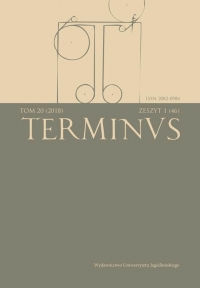Ars Amandi, Ars Dictandi – średniowieczna Pseudo-Ars amatoriai jej funkcje dydaktyczne w Akademii Krakowskiej
Ars Amandi, Ars Dictandi– Medieval Pseudo-Ars Amatoria and Its Didactic Functions at Cracow University
Author(s): Adam JegorowSubject(s): Cultural history, Social history, Middle Ages
Published by: Wydawnictwo Uniwersytetu Jagiellońskiego
Keywords: Pseudo-Ars Amatoria; pseudoovidiana; Cracow University; ars dictaminis
Summary/Abstract: This paper presents the reception of the medieval didactic poem known as Pseudo-Ars Amatoria in the environment of Cracow University. The poem, attributed to Ovid, was most probably written in the 12th century. Three of the codices that include the text are stored in the Jagiellonian Library (BJ 2035, 2115, 2233). Due to the unquestionable fact that the manuscripts were used in the academia, the purpose of the study is to determine the role that Pseudo-Ars Amatoria had in the teaching process at Cracow University. Previous research was devoted to preparing the text’s critical edition and pointing out the relationship with amour courtois and the oeuvre of Ovid. Considering the assumptions of Jaussian reception theory, the paper reconstructs the spectrum of reading experiences based on manuscript testimonials that refer to the two above mentioned hypotexts. The main part of the study therefore consists of three chapters. The first one discusses the courtly love motifs present in the work. Based the concept of Peter Allen (The Art of Love: Amatory Fiction from Ovid to the ‘Romance of the Rose’), which emphasizes the primary literary dimension of amour courtois, the author stresses the didactic potential of medieval love textbooks. The second chapter is devoted to the medieval reception of Ovid’s Ars Amatoria, which is imitated in the anonymous work in question, and the intertextual connections noticeable at the level of structure and subject matter, due to which Pseudo-Ars Amatoria was recognized as the work of the ancient poet, and so endowed with auctoritas, characteristic of school texts. In the third chapter, the author supplements the observations concerning the literary context with an analysis of messages found in Cracow manuscripts. He discusses the contents of the codices and their origin in the context of curriculum reforms related to the growing interest of ars dictaminis, proving the usefulness of the medieval poem in the art of writing. He supports his conclusions with comments regarding other codices. The Boncompagno da Signa’s Rota Veneris treaty (BJ 2458) serves as a starting point for the approximation of the basic themes of ars dictaminis, which are then distinguished as the compositional axis of the central part of the poem. In order to document the didactic potential of Pseudo-Ars Amatoria, the author refers to information about the ‘lost witnesses’ of the transmission, Jan of Słupca’s codexdescribed by A. Brückner in Medieval Latin Poetry in Poland and the codex of Stanisław Ciołek's chancellery, presented by B. Ulanowski in Liber formularum ad ius Polonicum necnon canonicum spectantium in codice Regiomontano asservatarum, as well as unpublished marginal notes from BJ 2115. In summary, there are two primary teaching objectives resulting from reading the work in the Cracow University milieu, which correspond to P. Allen’s conclusions regarding the exact meaning of the textbooks of courtly love and the main directions of the reception of Ovid’s teaching poems. Pseudo-Ars Amatoria was considered a school text, adequate for transmitting the basics of Latin grammar, similar to its ancient model, and, due to the suitable subject matter and applied rhetorical figures, especially useful in explaining the rules of ars dictaminis.
Journal: TERMINUS
- Issue Year: 20/2018
- Issue No: 3 (48)
- Page Range: 281-309
- Page Count: 29
- Language: Polish

